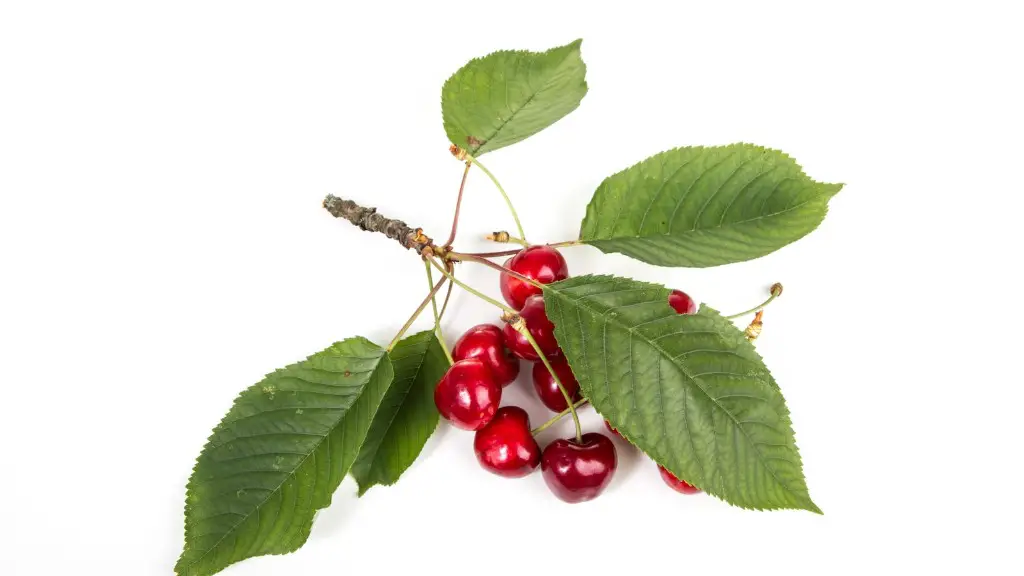Planting Process
The planting process can be intimidating to anyone who is not well-versed in gardening. But with the right knowledge, anyone can plant a bing cherry tree with success. When planting, select the right site and make sure that no building, water line or other underground utility is under where the cherry tree will be planted. Then, pick the right time of year to plant and prepare the soil properly.
Select Site
Select a site with good sun exposure and with an adequate supply of water. Bing cherry trees need full sun, as they require 6-8 hours of direct sunlight for proper growth. Also, the soil should be well-drained, slightly acidic and fertile. Ensure that the site is clear from roots of other trees or rocks that can compact the soil.
Choose Right Time
When planting bing cherry trees, pick the right time for the planting process. Early spring is the best time, as the weather is mild. Late fall and winter should be avoided, as these can be too cold for the trees. The young trees need to establish themselves in a more temperate climate and an early spring will help them develop more quickly.
Soil Preparation
Soil preparation is essential when planting bing cherry trees. Remove large pieces of debris and loosen the soil to allow the roots to spread. The holes should be 4-6 feet in circumference and deep enough to accommodate the fully-grown tree. Add compost to improve soil nutrition. Do not add fertilizer but water the soil before planting. Additionally, the area should be kept weed-free to eliminate competition for nutrients.
Planting Steps
When planting the bing cherry tree, make sure that the roots are spread out in the bottom of the planting hole and the tree is placed straight up. Make sure that the soil is filled in the holes and that all the air pockets are removed. The soil should be gently pressed to ensure that the tree gets a firm hold and so that no air gaps remain. Water the tree frequently, especially in the first few weeks until the root system is fully established in the soil.
Staking
Staking is important for newly planted bing cherry trees, as it will protect them from strong winds. Choose a stake that is strong enough to provide support for the tree. Drive the stake into the soil. Tie the stake to the tree using a soft ropes, so that it won’t damage the tree. Make sure the stake is securely attached to the tree and that it will still give the tree enough room to move with the wind.
Pruning and Maintenance
Pruning is necessary for bing cherry trees to maintain a proper shape, get rid of old branches, and control disease and pests. Prune in the early spring and remove any dead branches you can see. Also, use pruning shears to eliminate any broken or diseased branches. Once the bing cherry trees are fully grown, they need regular watering and fertilizing to ensure that they remain healthy.
Managing Insects and Diseases
Bing cherry trees are prone to certain insects and diseases. Common diseases include brown rot, root rot and powdery mildew. To prevent insect infestations and diseases, practice regular monitoring and treat any problems early. Additionally, to ensure healthy trees, ensure they get the proper amount of water, sunlight and nutrition.
Harvesting
Harvesting the bing cherry tree should not be done before the tree is fully matured, which is about 4-6 years after it was originally planted. The best time for harvesting is in the summer, as this is when the fruit will be at its ripest and will have the most flavor. Pick the fruit with a gentle hand and use a scissors to cut the stem, never pull the fruit from the stem.
Caring for Fruit
Once the cherry fruits of the bing cherry tree are harvested, they must be handled with care. It is important to store the cherries in breathable containers and not to stack them too high. To keep them fresh, it is best to keep the cherries refrigerated. Provide the right moisture levels and temperatures, as too much of either can spoil the cherries.
Tools and Equipment
When planting, maintaining, and harvesting bing cherry trees, it is important to use the right tools and equipment. Use a shovel and spade to dig the hole, a trowel to move soil around, pruning shears for pruning, and a picker or ladder to harvest the fruit. Also, safety gear such as gloves, protective glasses, and a hat are recommended for protection.
Protecting the Environment
When taking care of bing cherry trees, it is important to adhere to environmental friendly practices. Make sure not to overuse fertilizers and chemicals, as these can be harmful to the environment. Do not mow too close to the trees and be mindful of any runoff water from the soil. Additionally, use biodegradable mulch and compost for maintenance, as these will be better for the environment.
Harvesting Methods
Harvesting bing cherries can be done in many different ways, depending on the desired outcome. For the best flavor, pick the fruits when they are ripe, as this will give them the best flavor. For longer shelf-life, pick the cherries when they are still slightly under-ripe, as this will give them a longer storage time. Additionally, cherry fruits can be frozen to extend the shelf-life even further.
Pest and Animal Control
Animals such as birds, deer, and squirrels love the sweet taste of the bing cherry tree. Therefore, in order to enjoy the fruit, it is important to employ some form of pest and animal control. Place netting or chicken wire around the tree to protect it from roaming creatures. Additionally, use repellants or traps to get rid of unwelcome guests.
Preserving Fruits
Once the bing cherries are harvested, there are various ways of preserving them for future use. Fruits can be frozen or canned for longer shelf-life. For jams and jellies, they can be boiled to extract the juice and make preserves. Additionally, dried fruits can be made by drying out the fruits in the sun or oven.


